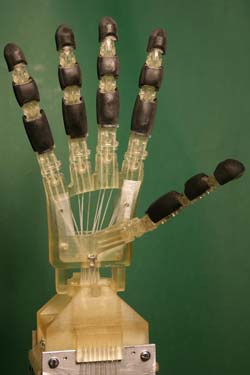Twisted String Actuator Imparts Robotic Hands with a Strong Grip

Researchers at Saarland University and Bologna University (Professor Claudio Melchiorri) developed a twisted string actuator for robotic hands. Bologna University
Imparting robots with the grip of their human counterpart demands hands capable of carrying heavy objects as well as placing them carefully and gently.
Researchers at Saarland University developed a twisted string actuator for robotic hands that is capable of generating tremendous forces by means of a simple principle, while requiring little space. The catapults of the ancient Romans serve as a model for the artificial muscles.
The new miniature drive will be presented by the scientists at the Hannover Fair from April 19th to 24th . The Saarland research booth C44 is located in Hall 2.
Already the Romans used strings and tendon bundles to catapult enormous stones on their enemies. Back then the strings were also twisted about their own axis, setting free immense forces when released. The research group of Hartmut Janocha, professor of Process Automation at Saarland University, took this archetype for the modelling of robot hands, which should be able to grip powerfully yet gently.
“Humans move their hands using muscles in the forearm. That is why we were searching for a possibility to control and activate the fingers with the smallest possible components inside the forearm of the robot”, said Professor Janocha, describing the challenge they faced. Using strings twisted by small, fast turning motors, the researchers can now generate high forces in a compact space.
“Extremely resilient polymer strings make it possible to hoist a load of five kilograms over 30 millimetres in less than a second, using an electric motor together with a string of 20 centimetres length”, explained Professor Janocha. Each finger of the robotic hand developed by the research team around Professor Claudio Melchiorri at Bologna University, which like its human archetype is comprised of three phalanges, can be controlled delicately with the individual tendons. Compared with conventional solutions in which strings are wound around a spool, this new solution is significantly more compact. The miniature electric motors will be integrated within the fore-arm of the robot, making it even more similar to the human arm. “The miniature motors run at high speed and with a low torque of about 5 Newton-millimetres. The combination of compact motors with twisted strings can be advantageous in other applications”, says Professor Janocha.
The research on robotic hands in Saarbrücken is part of the European funded project DEXMART, in which eight universities and research institutes from Germany, France, Italy and Great Britain participate. The goal of the project is to impart robots with specific properties so that they can assist persons in the household, in operating rooms or industrial settings. Starting in 2008, the European Union is investing 6.3 million Euro over four years in the research project.
For more information, contact:
Chris May
Laboratory of Process Automation (LPA)
Saarland University
Tel. +49 (0) 681 / 302-4188
Tel. +49 (0) 511 / 89 49 71 01 (telephone at exhibition booth)
c.may@lpa.uni-saarland.de
Media Contact
All latest news from the category: Machine Engineering
Machine engineering is one of Germany’s key industries. The importance of this segment has led to the creation of new university degree programs in fields such as production and logistics, process engineering, vehicle/automotive engineering, production engineering and aerospace engineering among others.
innovations-report offers informative reports and articles covering technologies such as automation, motion, power train, energy, conveyor, plastics, lightweight construction, logistics/warehousing, measurement systems, machine tools and control engineering.
Newest articles

Combatting disruptive ‘noise’ in quantum communication
In a significant milestone for quantum communication technology, an experiment has demonstrated how networks can be leveraged to combat disruptive ‘noise’ in quantum communications. The international effort led by researchers…

Stretchable quantum dot display
Intrinsically stretchable quantum dot-based light-emitting diodes achieved record-breaking performance. A team of South Korean scientists led by Professor KIM Dae-Hyeong of the Center for Nanoparticle Research within the Institute for…

Internet can achieve quantum speed with light saved as sound
Researchers at the University of Copenhagen’s Niels Bohr Institute have developed a new way to create quantum memory: A small drum can store data sent with light in its sonic…





















